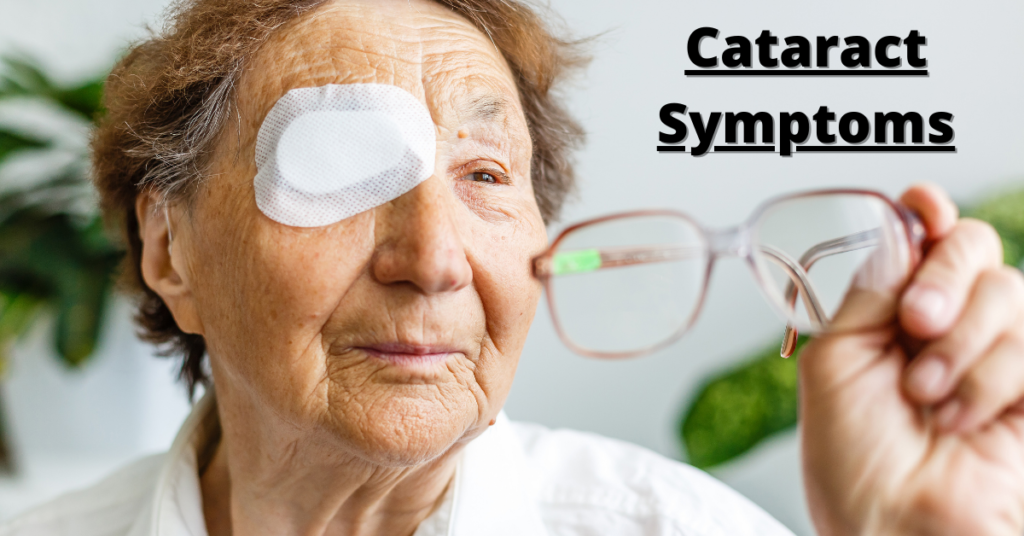Contents
What Are Cataract Symptoms?
A cataract is a condition when a person is not able to see clearly through his /her eyes due to the clouding in the normally clear lens. This situation is not something that can happen overnight. With the slow passage of time, this situation starts developing and can start causing disruptive and blurred vision. Generally, people start getting Cataracts at the age of 40, but the cataract symptoms will not show till the age of 60.
Understanding Cataracts

A cataract is the clouding in your eye. A natural lens is in your eye behind your iris (which is the colored part of your eye). This natural lens helps to bend the incoming light which allows us to see. In a normal situation, this natural lens is clear. But sometimes due to certain reasons, clouding forms in your lens known as called cataract.
With the Increasing age, everyone becomes more prone to cataracts as age is the primary risk factor there. With the increasing age, the protein content in the natural eye lens starts to change due to gradual and natural changes. They start to break down around the age of 40.
How Do You Know If You Have Cataract?
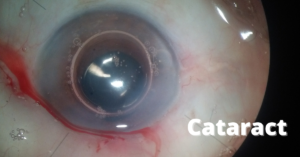
The lens of your eye is used everywhere and every time of the day from reading to watching. There are certain behaviors or negligence that can cause a situation like this such as Smoking, High Blood Pressure, Exposure to radiation, Using steroid medicines, Roaming in sun without much time without protection. These reasons can cause Cataracts.
However, there are some Cataract Symptoms such as:
Cloudy Days
Cataracts initially have a much lesser effect on your eye. However, over time, the situation starts worsening and your vision starts becoming unclear and cloudy. The surroundings will start becoming blurry, dull, or dim. Sometimes people can see their vision clear due to nuclear cataracts and this situation is “Second Sight”.
Need For New Glasses Again
If you are needing new glasses now and then on a very frequent basis, the reason may be cataracts. Buying expensive and strong Eyeglasses will not help in this situation. You need to visit a doctor real soon and get your eyes tested.
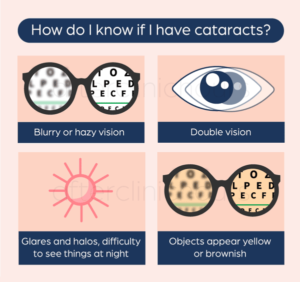
Yellow Tint In The Eye
When the Cataract starts developing, the clumps of the protein that are formed in your lens and cause clouding starts to get a little yellowish and brown. This is due to the light that comes into your eye having a yellow tint. This causes how you see the colors and it reduces the ability of you to differentiate between the colors.
Different Health Problems
There are different health problems that can definitely be symptoms of Cataracts such as Diplopia and Binocular Double Vision.
- Diplopia is the situation when the diffraction in the lens results in seeing two images of one object.
- Binocular Double Vision is the situation when two images are visible only if both eyes are open.
Glare and Halos Everywhere
The diffraction of light that enters your eye can cause Halo around the light sources. Driving can become very difficult due to the rings that are formed around the lights. The glare of bright lights can be painful. This can cause difficulty in counting the number of lights. You become more sensitive to light than usual.
Difficulties In Various Activities
You can face a lot of difficulties in various activities like reading newspapers, seeing in the distance, walking and using stairs. Due to the cloudy formation, the clearance ability of your eyes becomes very less and you have hurt or cause severe harm to yourself. Midnight driving can become difficult. This can increase the chances of accidents.
If you have been observing these symptoms for quite some time, one must visit a specialist and have a regular eye test. The optician will detect the symptoms and may refer you to the hospital.
Symptoms Of Different Types Of Cataract
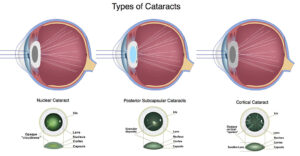
The different types of Cataract and their symptoms are as follows:
Nuclear Sclerotic Cataract
These are the most common type of Cataract. This is an age-related eye condition in which the center part of the lens gets a little bit cloudy or hardens. The Centre of your lens is basically for receiving light, so hardening impacts vision.
Nuclear Sclerotic Cataract Symptoms
- Affected distance vision
- Blurry and Clouding of vision.
- Frequent change of lenses and prescription.
- Trouble seeing at night
- Difficulty in distinguishing colors
Cortical Cataract
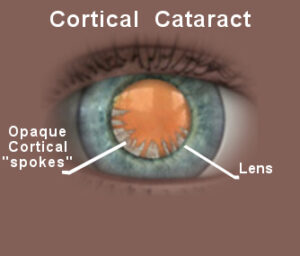
This is a type of Cataract that initially develops at the edge of the eye, but it can slowly affect the center of the eye. As the condition gets worse, the light that enters the eye disperse. This condition affects the eye either rapidly or develops slowly and remains in the eye for a very long period of time. Two types of Cortical Cataract are:
- Posterior Cortical Cataract
- Anterior cortical cataract
Cortical Cataract Symptoms
- Burred Vision
- Difficulty to differentiate between colors
- Difficulty to find objects that are near or far
- Double Vision
Posterior Subcapsular Cataract
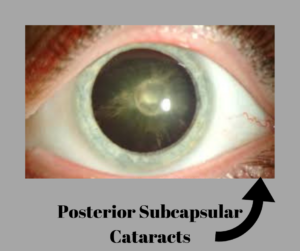
This is a type of Cataract that develops as a small opaque and cloudy area at the back of the lens. It is named subcapsular because it is formed under the layer of the lens capsule. This is a small membrane that helps the lens to enclose and holds the lens in a place. This is a type of lens that can occur individually or with a combination of different cataracts as well. It can cause a reduction in vision and can affect your reading ability. These cataracts develop at a fast rate in comparison to other types of Cataracts.
Posterior Subcapsular Cataract Symptoms
- Blurred Vision
- Defect in near vision
- Deduction in Contrast Sensitivity.
- Diplopia or Polyopia

